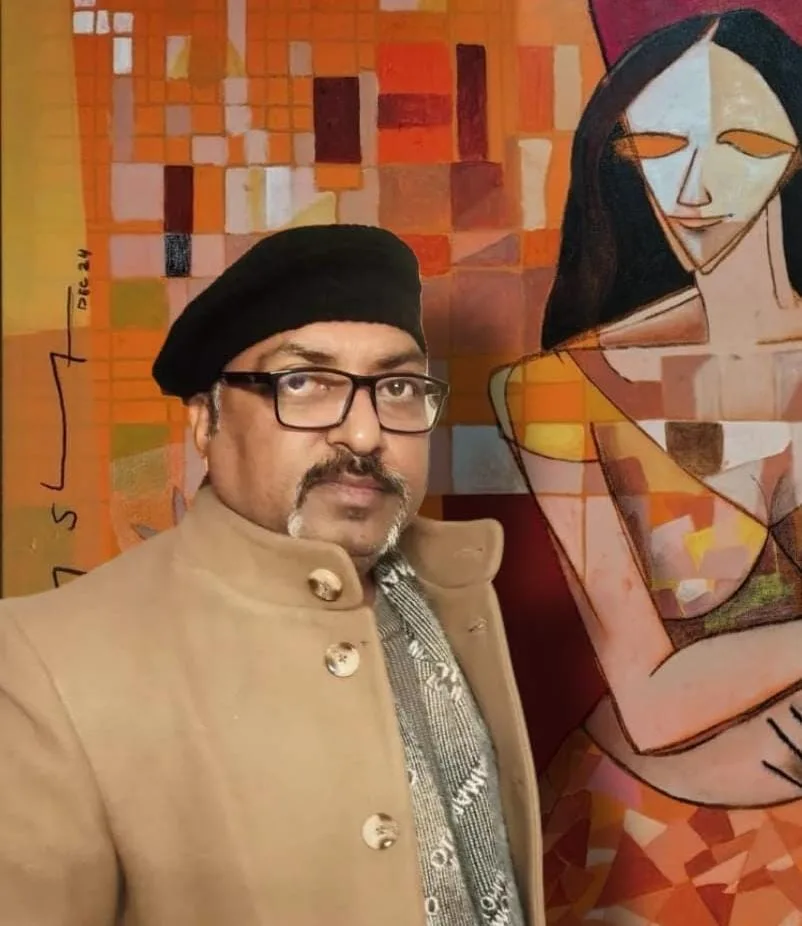Radhey Shyam is an eminent visual artist with over 25 years of artistic practice. Working primarily in oil, acrylic, oil pastel, and charcoal, he composes evocative human figures—especially feminine forms—set against textured backgrounds to portray beauty, emotion, and human relationships. An artist, educator, researcher, and curator, he has showcased his works in two solo and over seventy group exhibitions across India and abroad, including Italy, UAE, Bhutan, London, Mauritius, Bangladesh, and Indonesia. His notable accolades include the Rastriya Abheudya Samman (2007), International Rajat Samman (2023), National Honor by Eastern Foundation of Art and Culture (2024), and the Amrita Sher Gill National Award (2025). His works are part of prestigious collections, including Rashtrapati Bhavan, Lalit Kala Akademi (Lucknow), Liwa Art Hub (UAE), and SCERT, Government of Delhi.
Could you tell us what inspired your latest collection and the vision behind it?
Attraction of Beauty Series, my latest collection, is a visual exploration of the timeless essence of femininity—its strength, grace, and emotional depth—expressed through an interplay of form, texture, and symbolism. Each work features a female figure set against a richly textured background, drawing the viewer into a space where emotion and atmosphere merge. The vertical format enhances the sense of presence, as if the figures exist in a realm beyond the everyday. Geometric forms flow through the compositions, symbolizing the balance between structure and freedom, control and spontaneity.
Is there a recurring visual or narrative thread connecting the works?
At the core of my latest work is an intimate exploration of the feminine spirit—its strength, vulnerability, and emotional complexity. Each piece is thoughtfully composed, with textures, forms, and colors chosen to evoke specific emotional tones. Vertical compositions elevate the figures, suggesting their presence in a space between the tangible and intangible. Geometric forms intertwine with the figures, reflecting a balance between structure and fluidity, control and surrender. This creates a rhythmic flow across the series, linking each work through a shared visual and emotional language.
Over the years, who do you find is most drawn to your art? Has your audience evolved with time?
Over the years, my work has resonated with a diverse audience, including art collectors, galleries, and institutions that appreciate my unique style and expressive approach. My way of portraying emotions through form and texture has been well-received by viewers who connect with the depth and storytelling within my pieces. Art lovers and collectors have embraced my work at prestigious venues like NGMA, New Delhi, Liva Art Hub, UAE, and exhibitions with the Government of Delhi, as well as in numerous private collections. While my audience has grown, the core remains those who are drawn to the intricate balance of emotions, femininity, and abstraction in my art.
Reflecting on your last three exhibitions, how did each of them shape your artistic evolution and current direction?
Each of my last three exhibitions has significantly influenced my artistic journey. The Memory of Ramkinkar Baij in Kolkata deepened my interest in expressive forms and textures, while Rang Tarang in Delhi encouraged bold use of colour and movement through audience engagement. Rang Marudhara in Rajasthan connected me with cultural and folk elements, enriching my use of earthy tones and geometric forms. Together, these experiences strengthened my confidence in blending abstraction with realism and shaped my current focus on emotional depth, vertical composition, and the evolving portrayal of femininity in contemporary art.
Your work appeals both to long- time collectors and new admirers. How do you strike that timeless balance?
I ensure my work remains timeless by continuously evolving while staying true to my artistic vision. Feedback from collectors, curators, and audiences helps me refine my approach, allowing my art to resonate across generations. Engaging with new opportunities, such as exhibitions, collaborations, and residencies, keeps my work dynamic and relevant.
How would you describe the evolution of your themes and artistic style over your last few collections?
Over my last three collections, my artistic approach has become more refined and emotionally layered, evolving from direct figurative narratives to more abstract and symbolic storytelling. While the feminine spirit remains central, my portrayal has grown more introspective, using textured backgrounds, intricate geometric forms, and evolving color palettes.
Looking forward, what concepts or directions are you eager to explore in your upcoming projects?
As I look ahead, I am excited to expand my artistic journey onto a global stage through international exhibitions and collaborations. Engaging with diverse audiences and art communities worldwide will allow me to explore new cultural influences while staying rooted in my signature style. I am also focusing on building strong associations with auction houses and collectors.
Which artists—past or present—have most influenced or inspired your creative philosophy?
I deeply admire Raja Ravi Varma and Tyab Mehta for his ability to blend Indian traditions with a European academic painting style, creating timeless works that continue to inspire generations. His mastery of storytelling through art, along with his portrayal of grace and emotion, has influenced my approach to capturing the feminine spirit. Additionally, I draw inspiration from Cubist artists like Pablo Picasso and Georges Braque, whose innovative use of geometric forms and fragmented perspectives reshaped modern art.
Finally, what would you like to say to emerging artists navigating their early years in this field?
For emerging artists, it’s essential to build a strong foundation by mastering fundamentals like sketching and drawing, as they sharpen one’s sense of detail, proportion, and composition. These core skills provide the confidence and clarity needed to explore and grow creatively. Patience, persistence, and a commitment to continuous learning are key, as artistic success is a journey of self-discovery rather than instant achievement.

